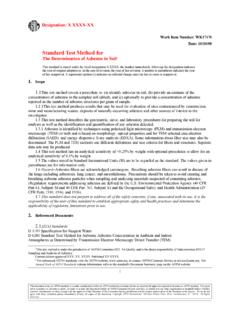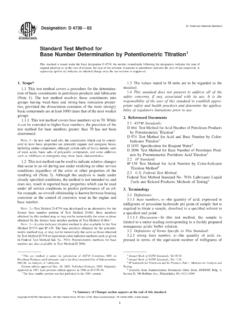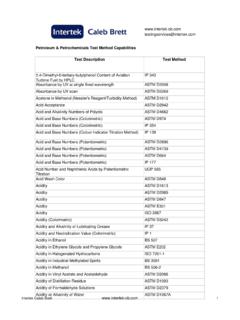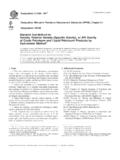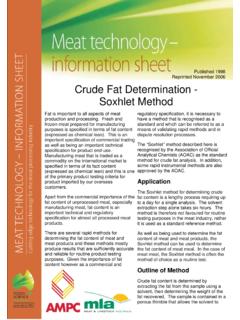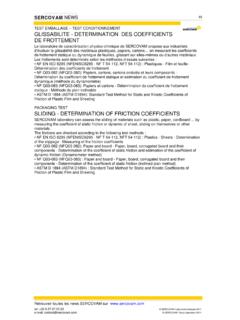Transcription of METHOD 24 DETERMINATION OF VOLATILE …
1 METHOD 24 8/3/2017 1 While we have taken steps to ensure the accuracy of this Internet version of the document, it is not the official version. To see a complete version including any recent edits, visit: and search under Title 40, Protection of Environment. METHOD 24 DETERMINATION OF VOLATILE MATTER CONTENT, WATER CONTENT, DENSITY, VOLUME SOLIDS, AND WEIGHT SOLIDS OF SURFACE COATINGS Scope and Application Analytes. Analyte CAS No. VOLATILE organic compounds Water No CAS Number assigned 7732-18-5 Applicability. This METHOD is applicable for the DETERMINATION of VOLATILE matter content, water content, density, volume solids, and weight solids of paint, varnish, lacquer, or other related surface coatings. Precision and Bias. Intra-and inter-laboratory analytical precision statements are presented in section No bias has been identified.
2 Summary of METHOD Standard methods are used to determine the VOLATILE matter content, water content, density, volume solids, and weight solids of paint, varnish, lacquer, or other related surface coatings. Definitions Waterborne coating means any coating which contains more than 5 percent water by weight in its VOLATILE fraction. Multicomponent coatings are coatings that are packaged in two or more parts, which are combined before application. Upon combination a coreactant from one part of the coating chemically reacts, at ambient conditions, with a coreactant from another part of the coating. Ultraviolet (UV) radiation-cured coatings are coatings which contain unreacted monomers that are polymerized by exposure to ultraviolet light. Interferences [Reserved] Safety METHOD 24 8/3/2017 2 Disclaimer.
3 This METHOD may involve hazardous materials, operations, and equipment. This test METHOD may not address all of the safety problems associated with its use. It is the responsibility of the user of this test METHOD to establish appropriate safety and health practices and to determine the applicability of regulatory limitations prior to performing this test METHOD . Hazardous Components. Several of the compounds that may be contained in the coatings analyzed by this METHOD may be irritating or corrosive to tissues ( , heptane) or may be toxic ( , benzene, methyl alcohol). Nearly all are fire hazards. Appropriate precautions can be found in reference documents, such as Reference 3 of section Equipment and Supplies The equipment and supplies specified in the ASTM methods listed in sections through (incorporated by reference see for acceptable versions of the methods ) are required: ASTM D 1475-60, 80, or 90, Standard Test METHOD for Density of Paint, Varnish, Lacquer, and Related Products.
4 ASTM D 2369-81, 87, 90, 92, 93, or 95, Standard Test METHOD for VOLATILE Content of Coatings. ASTM D 3792-79 or 91, Standard Test METHOD for Water Content of Water Reducible Paints by Direct Injection into a Gas Chromatograph. ASTM D 4017-81, 90, or 96a, Standard Test METHOD for Water in Paints and Paint Materials by the Karl Fischer Titration METHOD . ASTM 4457-85 91, Standard Test METHOD for DETERMINATION of Dichloromethane and 1,1,1-Trichloroethane in Paints and Coatings by Direct Injection into a Gas Chromatograph. ASTM D 5403-93, Standard Test methods for VOLATILE Content of Radiation Curable Materials. ASTM D 6419-00, Test METHOD for VOLATILE Content of Sheet-Fed and Coldset Web Offset Printing Inks. Reagents and Standards The reagents and standards specified in the ASTM methods listed in sections through are required.
5 Sample Collection, Preservation, Storage, and Transport Follow the sample collection, preservation, storage, and transport procedures described in Reference 1 of section METHOD 24 8/3/2017 3 Quality Control Reproducibility NOTE: Not applicable to UV radiation-cured coatings). The variety of coatings that may be subject to analysis makes it necessary to verify the ability of the analyst and the analytical procedures to obtain reproducible results for the coatings tested. Verification is accomplished by running duplicate analyses on each sample tested (Sections through ) and comparing the results with the intra-laboratory precision statements (Section ) for each parameter. Confidence Limits for Waterborne Coatings. Because of the inherent increased imprecision in the DETERMINATION of the VOC content of waterborne coatings as the weight percent of water increases, measured parameters for waterborne coatings are replaced with appropriate confidence limits (Section ).
6 These confidence limits are based on measured parameters and inter-laboratory precision statements. Calibration and Standardization Perform the calibration and standardization procedures specified in the ASTM methods listed in sections through Analytical Procedure Additional guidance can be found in Reference 2 of section Non Thin-film Ultraviolet Radiation-cured (UV radiation-cured) Coatings. VOLATILE Content. Use the procedure in ASTM D 5403 to determine the VOLATILE matter content of the coating except the curing test described in NOTE 2 of ASTM D 5403 is required. Water Content. To determine water content, follow section Coating Density. To determine coating density, follow section Solids Content. To determine solids content, follow section To determine if a coating or ink can be classified as a thin-film UV cured coating or ink, use the equation in section If C is less than g and A is greater than or equal to 225 cm2 (35 in2) then the coating or ink is considered a thin-film UV radiation-cured coating and ASTM D 5403 is not applicable.
7 NOTE: As noted in section of ASTM D 5403, this METHOD may not be applicable to radiation curable materials wherein the VOLATILE material is water. Multi-component Coatings. METHOD 24 8/3/2017 4 Sample Preparation. Prepare about 100 ml of sample by mixing the components in a storage container, such as a glass jar with a screw top or a metal can with a cap. The storage container should be just large enough to hold the mixture. Combine the components (by weight or volume) in the ratio recommended by the manufacturer. Tightly close the container between additions and during mixing to prevent loss of VOLATILE materials. However, most manufacturers mixing instructions are by volume. Because of possible error caused by expansion of the liquid when measuring the volume, it is recommended that the components be combined by weight.
8 When weight is used to combine the components and the manufacturer's recommended ratio is by volume, the density must be determined by section Immediately after mixing, take aliquots from this 100 ml sample for DETERMINATION of the total VOLATILE content, water content, and density. VOLATILE Content. To determine total VOLATILE content, use the apparatus and reagents described in ASTM D2369 (incorporated by reference; see for the approved versions of the standard), respectively, and use the following procedures: Weigh and record the weight of an aluminum foil weighing dish. Add 3 1 ml of suitable solvent as specified in ASTM D2369 to the weighing dish. Using a syringe as specified in ASTM D2369, weigh to 1 mg, by difference, a sample of coating into the weighing dish. For coatings believed to have a VOLATILE content less than 40 weight percent, a suitable size is + g, but for coatings believed to have a VOLATILE content greater than 40 weight percent, a suitable size is g.
9 NOTE: If the VOLATILE content determined pursuant to section is not in the range corresponding to the sample size chosen repeat the test with the appropriate sample size. Add the specimen dropwise, shaking (swirling) the dish to disperse the specimen completely in the solvent. If the material forms a lump that cannot be dispersed, discard the specimen and prepare a new one. Similarly, prepare a duplicate. The sample shall stand for a minimum of 1 hour, but no more than 24 hours prior to being oven cured at 110 5 C (230 9 F) for 1 hour. Heat the aluminum foil dishes containing the dispersed specimens in the forced draft oven for 60 min at 110 5 C (230 9 F). Caution provide adequate ventilation, consistent with accepted laboratory practice, to prevent solvent vapors from accumulating to a dangerous level. Remove the dishes from the oven, place immediately in a desiccator, cool to ambient temperature, and weigh to within 1 mg.
10 Run analyses in pairs (duplicate sets) for each coating mixture until the criterion in section is met. Calculate WV following Equation 24-2 and record the arithmetic average. Water Content. To determine water content, follow section METHOD 24 8/3/2017 5 Coating Density. To determine coating density, follow section Solids Content. To determine solids content, follow section Exempt Solvent Content. To determine the exempt solvent content, follow section NOTE: For all other coatings ( , water-or solvent-borne coatings) not covered by multicomponent or UV radiation-cured coatings, analyze as shown below: Water-or Solvent-borne coatings. VOLATILE Content. Use the procedure in ASTM D 2369 to determine the VOLATILE matter content (may include water) of the coating. Record the following information: W1=weight of dish and sample before heating, g W2=weight of dish and sample after heating, g W3=sample weight, g.










